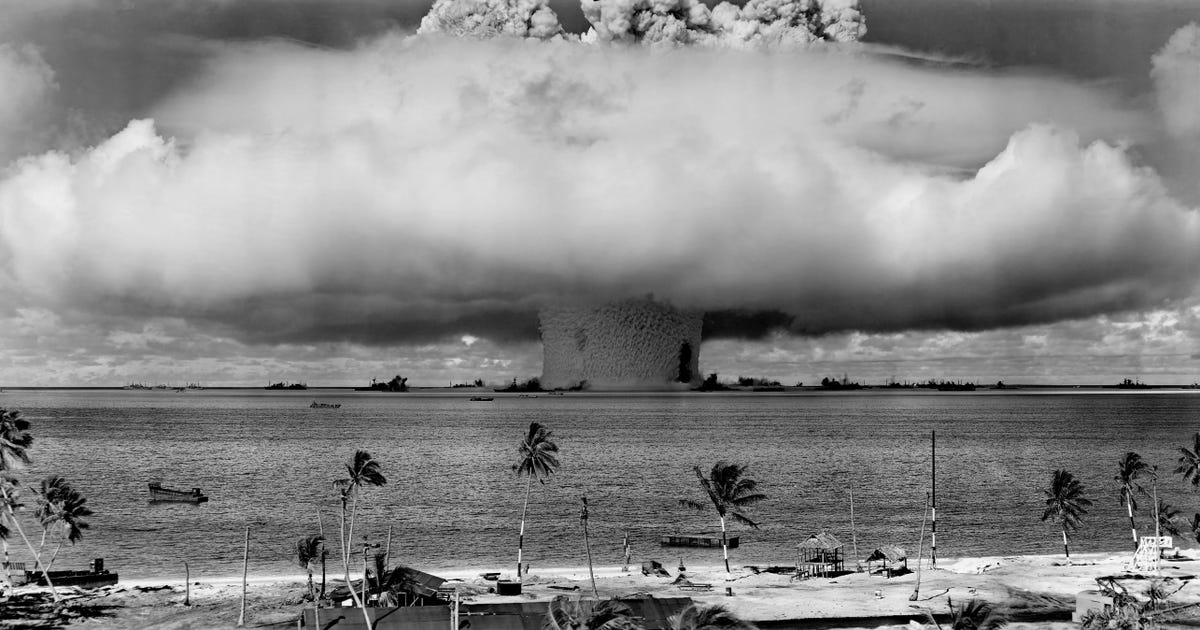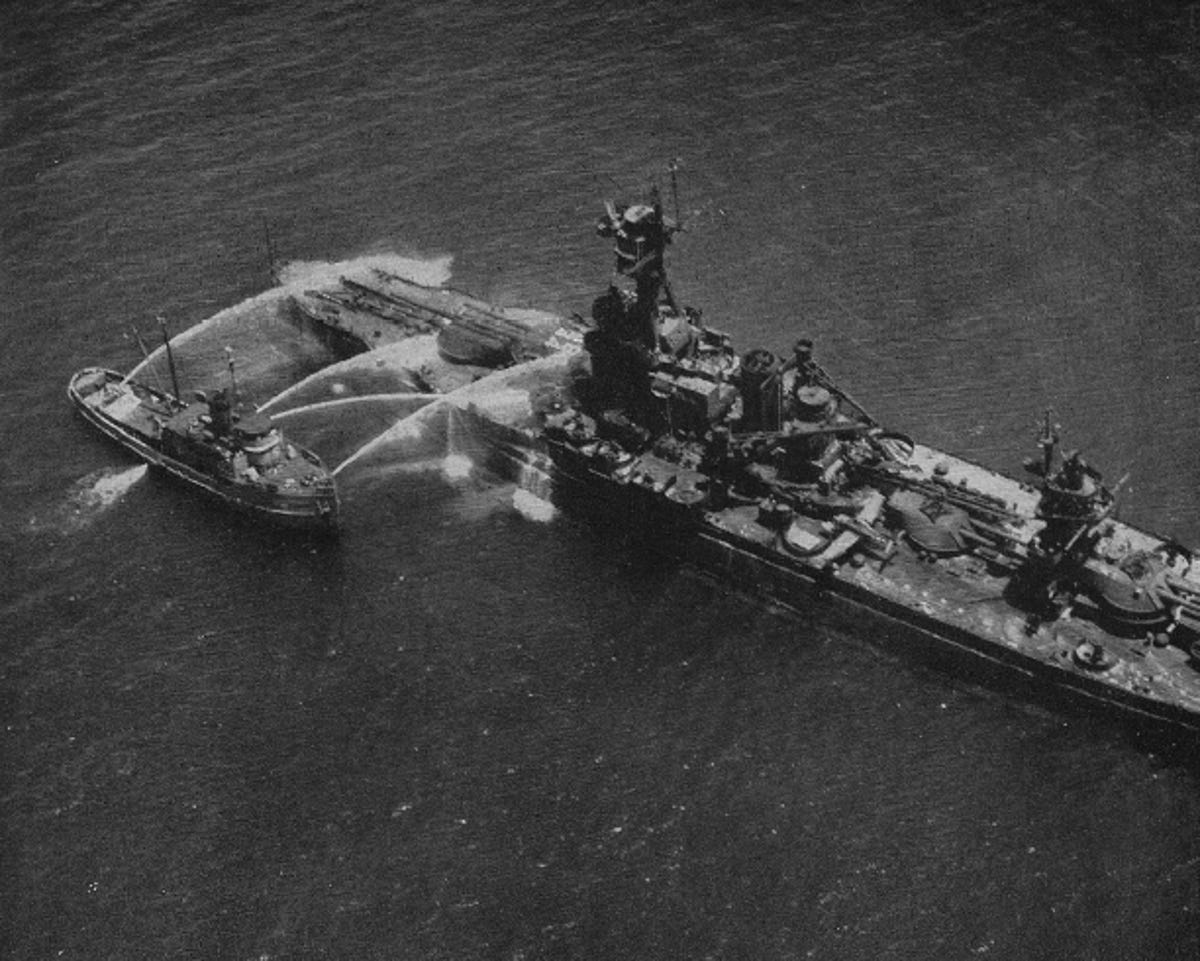An atomic anniversary for the Bikini Atoll (pictures)
Test Baker marked the first-ever underwater nuclear explosion when the 23 kiloton device was detonated on July 25, 1946.

Bikini Atoll mushroom cloud
Suspended 90 feet below the sea, anchored beneath an auxiliary craft in the midst of the target ghost fleet, the detonation of Test Baker marked the first-ever underwater nuclear explosion when the 23 kiloton device was detonated on July 25, 1946, at the Bikini Atoll lagoon, Marshall Islands, in the Pacific Ocean.
The device, which displaced 2 million tons of water, was the fifth of over 2,000 nuclear explosions conducted to date by the U.S. military. Only a few of the tests were underwater explosions, carried out primarily to research the impact to ships and submarines.
Test Baker, and Test Able on July 1, 1946, were part of "Operation Crossroads," a series of nuclear tests conducted during 1946. The massive project sought to answer questions about the effects of nuclear weapons on a fleet of ships and living animals. The operation involved 42,000 personnel, 242 ships, 156 airplanes, and the relocation of all 162 residents from the Bikini Atoll.
The Marshall Islands became quite familiar with the nuclear studies of the U.S. military. The Bikini Atoll became the site of another nuclear first when a B-52 dropped the first airborne hydrogen bomb on May 21, 1956.
The mushroom cloud and water column seen here resulted from the underwater Test Baker nuclear explosion of July 25, 1946, as seen from an observation tower on Bikini Island, 3.5 miles away from ground zero.
Detonation of Test Baker
This target fleet consisted of older U.S. capital ships, three captured German and Japanese ships, surplus U.S. cruisers, destroyers, and submarines, and a large number of auxiliary and amphibious vessels.
Mushroom cloud with ships below
Military equipment was also arrayed on some of the ships, and amphibious craft were berthed on Bikini Island. Following the test, the target fleet remained too radiologically contaminated for several weeks to do anything more than brief on-board research activities.
The inability to complete inspections on much of the target fleet threatened the success of the operation after Test Baker.
Able and Baker, the fourth and fifth tests
The bombs that ended World War II on August 6 and August 9, 1945, at Hiroshima and Nagasaki were the second and third nuclear detonations on Earth. The first bomb was detonated at Alamagordo, N.M., on July 16, 1945.
Operation Crossroads tests Able and Baker were the fourth and fifth tests, seeking a greater understanding of these powerful tools of war.
Water falls back from the stem
Mushroom cloud with ships below

Contaminated ships
Operation Crossroads consisted of two 23 kiloton nuclear detonations. Test Able detonated at an altitude of 520 feet on July 1, 1946, and Test Baker was detonated 90 feet underwater on July 25, 1946.
A third planned detonation, Test Charlie, was canceled after the United States Navy was unable to decontaminate ships used in the Test Baker experiments.
Decontamination efforts aboard Prinz Eugen
Target ships at Pearl Harbor
Drones, 1946
The plane was launched unmanned soon after the bomb was detonated on July 25, 1946. Instruments on board and photographic plates taped to the control stick obtained data on radioactivity. Unmanned drones -- which at the time were a huge feat for the military -- played numerous roles in these early nuclear tests.
It was the first operation in which takeoff, flight, and landing were accomplished with no one aboard. Drones are common in today's advanced military, but in 1946, the feat was an impressive one: many experts had thought it could never be accomplished with planes of this size.
Mushroom cloud cake
Radioactivity has entered the food chain
U.S. National Museum curator Leonard Schultz, kneeling at right, reviews specimens collected as part of the Bikini Resurvey in 1947. Also pictured, from left, are Vernon Brock, the director of fish and game division for the territory of Hawaii, A.C. Cole, professor of zoology and entomology at the University of Tennessee, and R.W. Hiatt of the U.S. Fish and Wildlife Service.
Scientists concluded: "Clearly radioactivity had entered the food chain. Plankton glowed on photographic plates, as did the intestinal tracts of the fish that fed on them. Only long term studies would show if the atoll would ever return to the ecological balance it enjoyed before Able Day."
Half a century later in 1997, the International Atomic Energy Agency reported that the Bikini Atoll was still uninhabitable.

